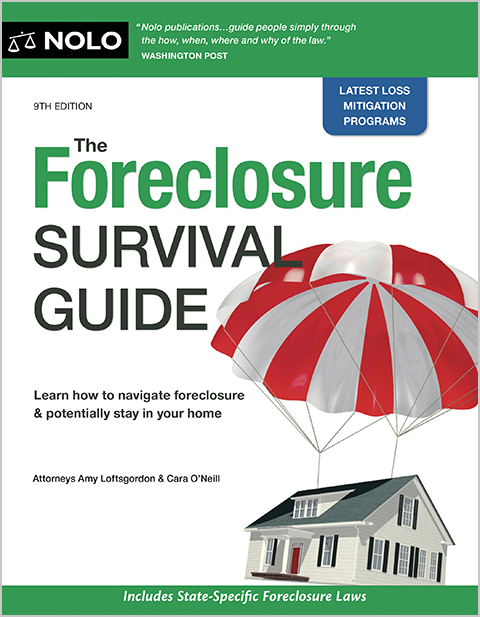The foreclosure rules for VA loans are the same as for other types of loans. However, under VA guidelines, the servicer has to give you every opportunity to avoid foreclosure.
Private lenders, like banks and mortgage companies, make VA-guaranteed home loans. The U.S. Department of Veterans Affairs (VA) guarantees a portion of the loan so the lender can offer more favorable terms to the borrower and provide loans to people who otherwise might not qualify for a mortgage. VA-backed loans are less risky to the lender because VA will cover losses if the borrower defaults. (The VA also offers a limited direct loan program. With a VA direct home loan, the VA is the mortgage lender.)
If you have a VA loan and are delinquent in mortgage payments, VA foreclosure guidelines say the servicer should work with you to help you avoid foreclosure. But if you can't find a solution to the delinquency, the foreclosure will go forward with state law governing the process—no different than any other foreclosure.
- What Are the Differences Between VA Loan Foreclosures and Other Foreclosures?
- What Are the Similarities Between VA Loan Foreclosures and Other Foreclosures?
- What Are My Options If I Am Facing a VA Loan Foreclosure?
- Deficiency Judgments After VA Loan Foreclosures
- Can You Buy a Foreclosed Property With a VA Loan?
- Getting Help With Foreclosure
What Are the Differences Between VA Loan Foreclosures and Other Foreclosures?
The VA requires servicers to work with borrowers who are behind in payments to bring the loan current or avoid foreclosure whenever possible. Borrowers with VA loans can access special options unavailable to borrowers with other kinds of loans.
But if you can't work something out, the foreclosure will begin.
Preforeclosure Requirements for VA Loans
Once a borrower fails to make a payment or multiple payments, the servicer has to attempt to contact the borrower by phone and mail and, in some cases, arrange a face-to-face meeting. (38 C.F.R. § 36.4350 (g),(h) (2025).)
The servicer's goal is to try to reach an agreement with the borrower to bring the loan current and discuss loss mitigation options (see below). (38 C.F.R. § 36.4350 (g),(h) (2025).) (Federal mortgage servicing laws also require the servicer to contact the borrower to attempt to resolve the delinquency.)
Under VA guidelines, in most cases, the servicer must send the borrower a letter within 30 days of the delinquency if the servicer can't make phone contact with the borrower. The letter should:
- State that the loan is in default.
- Emphasize that the delinquency is serious and stress the importance of taking prompt action to resolve the default.
- State the total amount due.
- Tell the borrower how to contact the servicer to make arrangements to cure the default. (38 C.F.R. § 36.4350 (g) (2025).)
The servicer must send another letter about loss mitigation options within 45 or 75 days of the default, depending on the situation. (38 C.F.R. § 36.4350 (g) (2025).)
Protections Against Foreclosure for Military Servicemembers
Also, depending on the circumstances, you might be entitled to protection against foreclosure under the federal Servicemembers Civil Relief Act or state law.
What Are the Similarities Between VA Loan Foreclosures and Other Foreclosures?
Under federal law, most homeowners, including those with VA loans, get 120 days to work out an alternative to foreclosure before the foreclosure can begin. But the foreclosure will start if you can't work out a loss mitigation option.
Once started, a VA loan foreclosure is the same as other foreclosures. State law governs the procedures. So, you'll get whatever foreclosure notices your loan contract and state law requires.
However, the VA encourages servicers to continue loss mitigation efforts even after a foreclosure starts.
What Are My Options If I Am Facing a VA Loan Foreclosure?
If you have a VA loan, there are several ways to avoid a foreclosure. A VA loan technician or housing counselor can help you determine the best option.
Financial Counseling
You can get financial counseling before and during the foreclosure process.
- Veterans and surviving spouses of veterans. You can receive financial counseling even if you have a different kind of loan (that is, a loan that isn't a VA direct or VA-guaranteed loan.)
- Borrowers with VA direct or VA-backed loans. If your mortgage loan is VA direct or VA-guaranteed, you can ask the VA to assign a VA loan technician to help you. These technicians can provide financial counseling and assist in dealing with your servicer (or work with you directly if you have a VA direct loan).
- Borrowers with VA direct or VA-backed loans that are 61 days past due. If your VA loan is over 61 days overdue, the VA will automatically assign a VA loan technician to help you.
Right to Reinstate the Loan
Under VA guidelines, the borrower generally gets the right to reinstate the loan and stop a foreclosure sale by paying all overdue payments, late charges, and foreclosure expenses. However, there are a few exceptions, like when state law precludes reinstatement. (38 C.F.R. § 36.4309 (h) (2025).)
Loss Mitigation Options for VA Loans
The VA expects the servicer to exhaust all possible alternatives before pursuing foreclosure. The main loss mitigation options for borrowers with VA loans are:
- getting a partial claim under the VA Home Loan Program Reform Act
- a repayment plan
- special forbearance
- a loan modification
- completing an assumption (you sell or transfer the property to someone else, and that person takes over the mortgage payments)
- refunding the loan (the VA buys the loan and takes on servicing responsibilities)
- completing a compromise sale (short sale), and
- doing a deed in lieu of foreclosure.
Deficiency Judgments After VA Loan Foreclosures
Whether the lender can get a deficiency judgment against you depends on whether state law allows it. However, even when state law allows a deficiency judgment, VA loan foreclosures are usually against the property only, not personally against the borrower.
If the lender makes a claim to the VA and the VA pays the claim due to a deficiency (remember, VA loans are guaranteed by the VA), the VA could come after you for the deficiency whether or not state law has an anti-deficiency statute. The VA has the legal authority to pursue indemnity after foreclosure (meaning, it could go after you for the deficiency) as established by the U.S. Supreme Court's decision in United States v. Shimer, 367 U.S. 374 (1961). Under 38 C.F.R. § 36.4323(e) (the "indemnity" regulation), veterans who default on VA insured or guaranteed loans remain liable for any deficiency after a foreclosure by the lender.
However, in practice, the VA rarely actively pursues collection of foreclosure-related indemnity from veterans. In fact, the VA website says that if your loan closed on or after January 1, 1990, and the VA has to pay back the amount of your loan to the servicer, you'll need to pay this amount back to the government only if they find evidence of fraud, misrepresentation, or bad faith on your part. But if you want to restore your full future benefit ("restoration of entitlement"), you'll need to pay back the amount the VA lost on the loan.
Can You Buy a Foreclosed Property With a VA Loan?
Getting Help With Foreclosure
Again, if you're a veteran with a VA-guaranteed or direct loan, the VA can get involved in your case, especially if you contact the nearest VA Regional Loan Center and ask for assistance. In some cases, the VA can provide a technician who can intervene with the servicer on your behalf, help you explore all options to avoid foreclosure, and conduct financial counseling with you. Contact a VA loan technician at 877-827-3702, Monday through Friday, from 8:00 am to 6:00 pm EST.
If the servicer fails to meet VA requirements or its obligations under state or federal law, you might have a defense to a foreclosure. If you have additional questions about how foreclosure works or want information about how to fight a foreclosure in court, consider talking to a foreclosure attorney.
Also, a HUD-approved housing counselor is another helpful resource for information, particularly regarding different loss mitigation options.
- What Are the Differences Between VA Loan Foreclosures and Other Foreclosures?
- What Are the Similarities Between VA Loan Foreclosures and Other Foreclosures?
- What Are My Options If I Am Facing a VA Loan Foreclosure?
- Deficiency Judgments After VA Loan Foreclosures
- Can You Buy a Foreclosed Property With a VA Loan?
- Getting Help With Foreclosure

